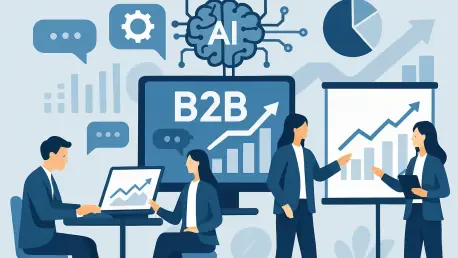In a digital landscape where trends shift faster than most businesses can adapt, B2B brands often find themselves grappling with a critical question: how can they stay relevant amid relentless change? Picture a financial services firm watching competitors engage audiences through dynamic social media campaigns while their own posts barely garner a glance. The gap between digital innovation and traditional strategy looms large, creating a pressing need for tools that can bridge this divide. This challenge underscores a broader reality—B2B sectors must evolve or risk obsolescence in a world that rewards agility and insight.
The importance of addressing this disconnect cannot be overstated. As digital platforms become the primary arena for brand visibility, B2B companies in conservative industries like professional services face unique hurdles. Falling behind means not just losing market share, but also missing the chance to shape industry conversations. Tools like AI and social listening offer a lifeline, providing the means to anticipate trends, understand audiences, and craft impactful strategies. Exploring how these technologies can redefine B2B marketing reveals a path toward sustained relevance and growth.
Challenges Facing B2B Brands in the Digital Era
Navigating the rapid pace of digital transformation presents a formidable obstacle for many B2B brands. Unlike B2C counterparts that often thrive on viral content, sectors such as financial services or legal consulting struggle with rigid internal processes that slow down adaptation. Social media platforms evolve with new features and algorithms almost daily, yet many companies remain tethered to outdated approval chains or risk-averse mindsets, hindering their ability to seize timely opportunities.
This lag creates a ripple effect across marketing efforts. When strategies are reactive rather than proactive, brands miss the window to engage meaningfully with their audience. The frustration of seeing competitors build loyal followings through innovative campaigns only amplifies the stakes. Without a shift in approach, B2B firms risk becoming invisible in a space where visibility equates to influence.
Consequences of Ignoring Digital Trends
The cost of failing to keep pace with digital expectations extends beyond mere optics. In an era where clients and partners expect brands to be active online, a lack of presence translates to diminished trust and authority. Research indicates that 68% of B2B buyers now rely on digital channels for purchase decisions, underscoring the urgency for companies to establish a robust online footprint or face irrelevance.
Moreover, the inability to harness emerging tools compounds missed opportunities. Engagement isn’t just about posting content—it’s about driving conversations that position a brand as a thought leader. Companies that ignore this shift often find themselves drowned out in an oversaturated market, unable to differentiate their value proposition from countless others vying for attention.
Harnessing AI and Social Listening for Strategic Growth
AI and social listening stand as powerful allies in reshaping B2B marketing frameworks. Strategic foresight, for instance, shifts the focus from chasing fleeting trends to building long-term engagement plans. A notable example involves a global accounting firm that revamped its social media approach by mapping out a year-long content strategy, resulting in a 40% increase in audience interaction compared to previous ad-hoc efforts.
Equally transformative is AI’s role in leveling the playing field through creative equity. Tools powered by artificial intelligence enable smaller teams to produce polished content and derive actionable insights from data, a capability once reserved for well-funded players. Recent studies reveal that 72% of marketers using AI report improved campaign efficiency, highlighting how technology empowers resource-constrained brands to compete effectively while maintaining a unique voice.
Social listening, often underutilized, offers another layer of advantage by uncovering hidden audience needs. By monitoring conversations across platforms, brands can detect industry shifts and refine their messaging accordingly. A case study from a financial advisory firm showed a 30% uptick in client inquiries after it adjusted its content based on sentiment analysis, proving that listening can be as impactful as broadcasting in building connections.
Expert Perspectives on Digital Innovation
Insights from industry leaders add depth to the conversation around digital transformation. Anna Lawlor, head of digital and social media at Greentarget UK and a juror for The Drum Awards Festival, emphasizes the primacy of strategy over mere execution. “Too often, brands rush to implement without a clear roadmap, which dilutes impact,” she notes, advocating for a deliberate approach that aligns digital efforts with overarching business goals.
Lawlor also addresses the ethical integration of AI, stressing the need to preserve authenticity. Her experience with professional services brands reveals that while AI can streamline content creation, human oversight ensures messages resonate genuinely with audiences. Paired with industry research showing that 65% of B2B marketers now use social listening to inform strategy, her perspective highlights a balanced approach to technology—one that values both innovation and integrity.
Her real-world application of these principles offers a compelling narrative. In working with a legal consultancy, Lawlor leveraged social listening to identify client pain points, shaping a campaign that boosted engagement by 25%. This anecdote reinforces the idea that blending strategic vision with cutting-edge tools can yield tangible results, even in traditionally cautious sectors.
Practical Steps to Elevate B2B Strategies
Implementing AI and social listening into B2B workflows requires a structured approach tailored to specific challenges. Start by crafting a comprehensive social media roadmap that prioritizes audience engagement over sheer content volume, aligning every post or campaign with long-term business objectives. This foundational step ensures that digital efforts contribute meaningfully to brand growth rather than serving as disconnected outputs.
Next, integrate AI tools for content ideation and data analysis, but maintain human oversight to safeguard brand authenticity. Platforms that offer predictive analytics can help identify trending topics, while AI-driven design tools streamline visual content production. Simultaneously, adopt social listening practices by using dedicated software to track audience sentiment and competitor moves, allowing for real-time campaign adjustments based on concrete insights.
Finally, commit to regularly assessing the balance between automation and personal input. Over-reliance on technology can erode the human touch that B2B audiences often value, so periodic reviews of processes help maintain equilibrium. By following these actionable steps, brands can navigate resource constraints and internal skepticism, paving the way for a digital presence that stands out in a crowded field.
Reflecting on Transformative Pathways
Looking back, the journey of integrating AI and social listening into B2B strategies revealed a landscape ripe with potential yet fraught with challenges. Brands that took bold steps to prioritize strategic planning over impulsive tactics often found themselves ahead of the curve, building stronger connections with their audiences. The insights shared by experts like Anna Lawlor served as a guiding light, showing that innovation need not compromise authenticity.
As these tools became more accessible, even conservative industries began to see the value in listening as much as speaking. The success stories of firms that adapted their approaches based on data-driven feedback stood as testaments to the power of thoughtful adoption. Moving forward, B2B marketers were encouraged to experiment with these technologies, starting small with pilot projects to test their impact on engagement and relevance.
The next horizon involved scaling these efforts while staying attuned to evolving digital expectations. Continuous learning and adaptation emerged as critical components for sustained success, urging companies to invest in training and resources that kept pace with technological advancements. By embracing this mindset, B2B brands positioned themselves not just to survive, but to lead in shaping the conversations of tomorrow.









